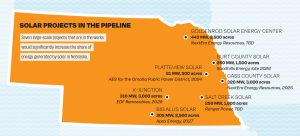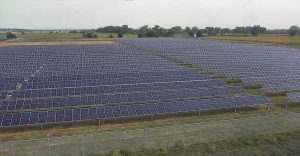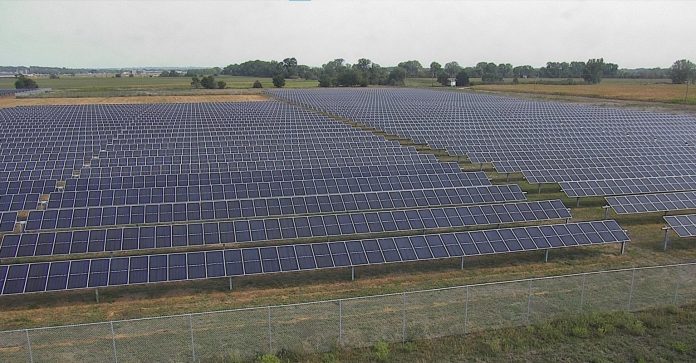The sun rises above a corn field in southern Lancaster County. Nebraska is poised for growth in solar energy in the coming years, as multiple large-scale projects are planned in the state. If all seven of those projects come on line, they would equal about 18% of Nebraska’s electric generation capacity as of 2021. (Courtesy photo)
Dan Griffith is just scraping by.
His work restoring windmills and the income from his farmland has kept the lights on, he said, but not much more.
That could change – if Griffith’s plans survive one of the latest controversies to grip rural Nebraska.
Griffith’s 160 acres in Lancaster County, typically planted with corn and soybeans, are prime real estate for Nebraska’s newest “cash crop”: solar power.
“I’ve been working dead-end jobs since I got out of college,” said Griffith, 40. “With the solar farm, once it gets going, I could see maybe in excess of six figures a year — steadily.”

Long after wind power’s arrival, large-scale solar energy is reaching Nebraska, with the first major project going on line next year. The 81-megawatt project will supply power to the Omaha Public Power District through solar panels situated across 500 acres. Six other large-scale projects are in the works, including the one in Lancaster County.
But where Griffith and others see opportunity, even necessity, some rural residents see betrayal. And it has sparked a backlash across the state, resulting in a lawsuit in Lancaster County, the recall of an elected official in Saunders County and solar zoning regulations in Kearney and Gage counties that are among the most restrictive in the nation.
The resistance factored into an OPPD proposal to back off its explicit commitment to add significant amounts of solar power. Instead the utility proposes to commit to “non-emitting” fuel, a change that it says will also give it more flexibility in responding to market conditions.
With solar, as with wind, Nebraska is at a crossroads: How — and whether — to integrate large-scale solar energy into the fabric of rural life?
The state already has numerous small solar projects, including about 20 that generate at least 1 megawatt, according to the Nebraska Department of Environment and Energy.

Nebraska’s largest operating solar farm is an 8.5 megawatt facility on the west side of Norfolk that went on line in 2022. Next year, a facility in Saunders County will go on line and become the largest operating solar farm in the state. (Photo courtesy of the City of Norfolk)
The seven projects in the pipeline are exponentially larger. Combined, they would generate about 1,900 megawatts of solar power, enough to equal about 18% of Nebraska’s electric generation capacity as of 2021, based on state and federal data.
Whether they all materialize in light of the coalescing opposition remains to be seen.
In Lancaster County, landowners opposing the $320 million Salt Creek Solar project have filed a lawsuit seeking to stop it. They argue that they purchased their acreages based on documents indicating that the adjoining land would remain agricultural. An attorney for the group said the lawsuit is not based on opposition to solar in general.
Attorneys representing the developer and four landowners contend that solar is indeed an agricultural use.
A judge is currently considering the case.
In Saunders County, Teresa Akeson and some of her neighbors tried to stop that project.
“The desire by big-money business to do and get what they want overruns local governments – all the way down to the little guy just trying to do the best they can for their families,” said Akeson.
When opponents failed to stop the project, they turned their attention to longtime Saunders County Board Member Doris Karloff, whose family owns property where the solar farm is being built. Karloff recused herself from the board discussion and the vote, which was unanimous. Still, her neighbors vented their anger by recalling her from office in 2021. Karloff could not be reached for comment.
Opposition in a few counties has been so intense, officials have enacted extensive buffer zones between solar panels and the homes of nonparticipating landowners.
Kearney County has required a quarter-mile buffer for several years. At the end of May, Gage County adopted regulations that include a half-mile buffer.
Emily Haxby, a Gage County board member who has worked for stricter regulation of renewables, said solar developers can “shrink” the setbacks by securing waivers from neighboring landowners, including, possibly by paying those landowners.
“I’m a fifth-generation farmer and I want to protect what I’m going to be passing along to my, hopefully, next generation,” she said. “I want to make regulations based on community decisions.”
The Gage and Kearney County setbacks are among the strictest solar buffer zones in the nation, said Matthew Eisenson, an attorney who leads the Renewable Energy Legal Defense Initiative at New York’s Columbia University.
Outside of those counties, Eisenson said Nebraska “appears to have relatively few serious restrictions on solar energy.”
A primary criticism of solar power is the amount of land it requires and whether renewable energy is a proper use of that land.
“(Solar) doesn’t produce electricity 24 hours a day, and they are trying to put it on the best dryland ag land in the state,” said Duane Murdoch, a Cass County Board member. “If you put it on poor land, I’m all for it.”
Utilities say solar is valuable because it generates power during the day when electrical demand is highest and it does so at a lower cost than alternatives.
Murdoch was among those who lobbied for stricter setbacks when Cass County wrote zoning rules that would govern a solar project NextEra Energy Resources is developing near Murray.
The Florida-based company has leased 3,000 acres. About 40%-50% of that will be for setbacks from roads and adjoining properties, riparian areas, drainage and trees, said Matthew Jones, project developer.
The project would use less than 1% of farmland in Cass County.
The Engelkemier family, who trace their Nebraska farm roots to 1875, wrestled for a year with whether to lease some of their land to NextEra.
They ultimately decided: Yes.
“One of the reasons I wanted to go into solar was to diversify our agricultural income source and allow the land to naturally rejuvenate during the solar lease,” said Larry Engelkemier. “We want to keep the farms in the Engelkemier name for future generations.”
The family sees solar as ag-based energy production, similar to ethanol and biofuels.
Currently, solar makes up less than 1% of Nebraska’s electricity, while coal constitutes almost 50% and wind about 25%. The rest is largely nuclear and hydropower, according to the state energy department.
For now, solar and wind are some of the best options for feeding the nation’s growing appetite for electricity, according to utility executives.
Global greenhouse gas emissions must fall by 43% by 2030 to avoid more devastating changes than ones already occurring in climate and life systems, according to the Intergovernmental Panel on Climate Change. Nebraska’s own climate scientists say it’s possible the state will warm so rapidly that by 2050 Nebraska’s average temperature will be similar to 2012 when extreme drought crippled agricultural output, wildfires consumed a record number of acres and numerous communities restricted water.
Nebraska’s major utilities have pledged to reach net zero carbon emissions in the decades ahead.
Difficulties bringing solar sites to life worries the head of OPPD.
By now, OPPD had hoped to have 600 megawatts of solar on line, according to President and CEO Javier Fernandez. Instead it is adding just 81 megawatts next year.
Local opposition hasn’t been the only hurdle – others have included supply chain problems, tariffs and regulatory slowdowns.
“If we want this state to continue to be prosperous and growing … we (need) to dispel the myth that, ‘Hey, this (wind or solar project) is a nice project to have,’” Fernandez told OPPD’s board in May. “A lot of these projects, we needed them yesterday, and we haven’t even broken ground. It’s going to be a challenge.”






